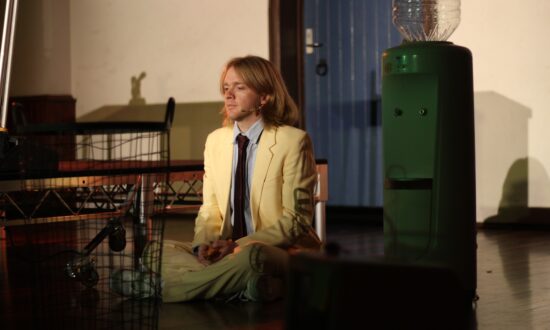Sam Kissajukian’s journey from stand-up comedian to visual artist began (as so many stories of reinvention do these days) in the early pandemic months. From his opening video montage, we learn that he spent this time self-isolating in a warehouse, painting up to 20 hours a day in a state of frenzied enthusiasm, aware all the while that a severe mental crash was probably looming.
With slideshow clicker in hand, black beret on head, and a real flair for storytelling, he takes us through the successes, schemes, and many, many paintings from that time which have since led to professional recognition and public exhibitions. We see how, having had no previous artistic background, he makes up for lost time by packing a lifetime’s worth of stylistic periods into those months.
Kissajukian paints on cardboard; he paints his dreams; he has a Blue Period. He creates demanding, metres-long pieces. He re-creates these same pieces as miniatures, puts the miniatures in dioramas, and composes music for them. There are light shows, shadow puppets, T-shirts, inventions, and convoluted, experimental business plans that get the attention of millionaires.
His central breakthrough, however, occurs in a psychiatrist’s office. That time in isolation, it turns out, was a five-month-long manic episode, and evidence of bipolar disorder.
Having swept us up in the exhilaration and agitation of his intense creative period, Kissajukian is just as engaging when he takes a step back to examine the relationship between his artistic process and his mental health. A life spent with a disorder or disability, he suggests, is by necessity a creative one, as everyday life presents challenges that require inventive problem-solving.
This is not the sort of stand-up that will have you rolling in the aisles, but it is absorbing, and it comes as a surprise when Kissajukian announces that our hour together is nearly over. The Mill – a multidisciplinary arts studio, performance and office space on Angas Street – is an ideal choice of venue for this unique show. If 300 paintings aren’t enough for you, there are plenty more by local artists to enjoy in the adjoining gallery.

Get InReview in your inbox – free each Saturday. Local arts and culture – covered.
Thanks for signing up to the InReview newsletter.
Kissajukian’s journey does not stop at 300, either. He tells us at the evening’s conclusion that his story (and the show itself) is ever evolving and still to be continued. As it stands now, it is a fascinating insight into one man’s experience of transformative personal and artistic growth.
300 Paintings is playing at The Breakout at The Mill until March 19.
Read more 2023 Adelaide Fringe stories and reviews on InReview here.
Support local arts journalism
Your support will help us continue the important work of InReview in publishing free professional journalism that celebrates, interrogates and amplifies arts and culture in South Australia.
Donate Here




